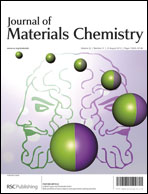Bio-based green composites with high performance were prepared from poly(lactic acid) (PLA) and microcrystalline cellulose (MC) fibers grafted with L-lactic acid oligomers (g-MC). The chemical structure of g-MC was characterized by fourier transform infrared (FTIR) and NMR methods, which indicate that L-lactic acid oligomers were successfully grafted onto MC. The grafting percentage of L-lactic acid oligomers is ca. 3.4%, and the average degree of polymerization of grafted L-lactic acid oligomers is ca. 10%. The improved compatibility between g-MC and PLA, caused by the grafting, results in an excellent dispersion of g-MC in the composites, and consequently a considerably improved transparence of the g-MC/PLA composites compared with that of the MC/PLA composites. In addition, due to the improved compatibility between g-MC and PLA, the g-MC/PLA composites exhibit better mechanical properties than pure PLA, with a high tensile strength of 70 MPa and a higher elongation at breakage. The enhanced properties, coupled with the excellent biocompatibility and degradability, offer the bio-based composites potential applications in biomedical fields and the packaging industry.

You have access to this article
 Please wait while we load your content...
Something went wrong. Try again?
Please wait while we load your content...
Something went wrong. Try again?


 Please wait while we load your content...
Please wait while we load your content...